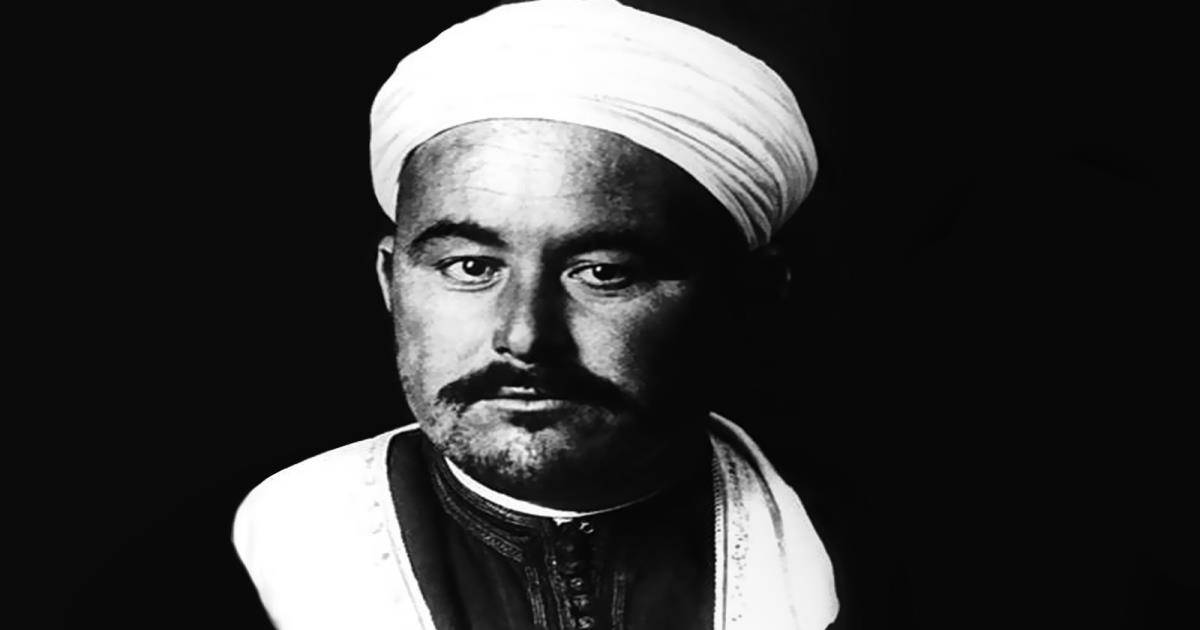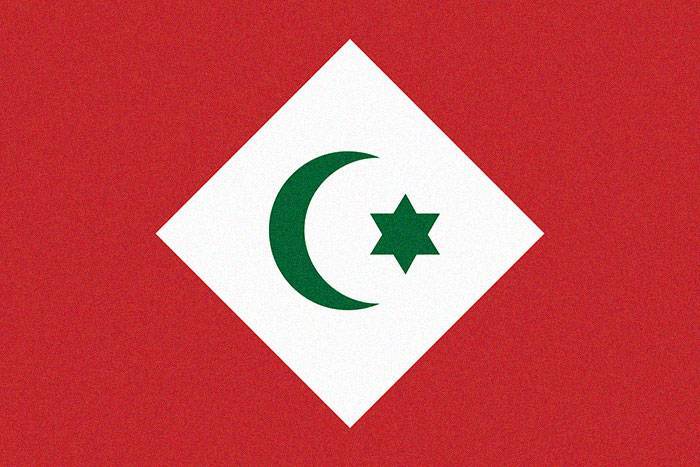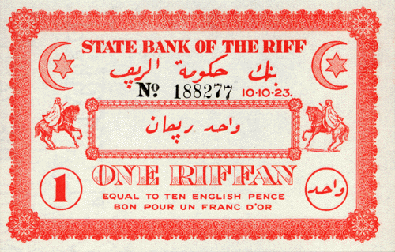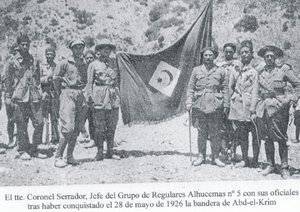Judge: Have you seen the flag of the Republic of the Rif?
Khaled: Beg your pardon?
Public Prosecutor: It's the red flag with the hexagonal star!
Khaled: You mean the symbol of colonial resistance?
This is a real conversation that took place in January 2018, between an activist in the Rif movement, Khaled Baraka in the Moroccan court, where a video was played showing him stand proud next to a flag of the Rif Republic, the symbol of his region's resistance to Spanish colonialism of the early twentieth century.
The trial of the Rif movement's detainees began in June 2017, following mass protests that shook northern Morocco between 2016 and 2017, following the killing of a fishmonger crushed to death inside a garbage truck. The court sittings would bear witness to writings which included the term "Republic of the Rif", as well as visuals and images in which the flag of the Rif republic made an appearance during the protests, and pictures of its founder Muhammad Ibn 'Abd al-Karim al-Khattabi, the leader of the Rif revolution against the Spanish and French colonial powers during the 1920s.
On the 28th of October 2016, authorities confiscated the unlicensed "Abu Saif" fish catch belonging to Mohcine Fikri. When the fishmonger attempted to stop police forces from damaging his "wealth" by jumping in the back of a garbage truck where he was crushed, sparking anger in Elhusima, provoking protests that spread to other regions of north Morocco, and which became known as the "Hirak Rif", the Rif movement.
During these trials, the court asked the detainees why they carried the Rif Republic flag and pictures of al-Khattabi, as well as mentioning the name of the Rif Republic in some of their Facebook posts – accusations which often sparked scenes of anger in court sessions, in protest against what Nasser Zefzafi – the leader of the protest movement – described as the "trial of al-Khattabi, the man who inspired leaders of liberation movements around the world."
The flag of the Rif Republic would often be a source of contention amongst those who took pride in it, raising it in protests. Despite the fact that the ceiling of the protesters' demands was low, centered on social reform, but many accused the movement of "separatism."

Muhammad Ibn 'Abd al-Karim al-Khattabi
Separatism or Identity?
On the 18th of September 1921, the Republic of the Rif was founded under the leadership of Muhammad al-Khattabi, following a string of victories he achieved in coalition with Rif tribes against the occupying Spanish army. At the time, Morocco was divided into both a Spanish and a French-controlled territory.
The political capital of the Republic was Ajdir, a town close to Elhusaima; the flag of the Republic was composed of a red cloth with a green star and crescent inside a white diamond, and would represent the first independent republic in the Middle East and North Africa.

Al-Khattabi's republic, which would last for five years, would stretch across a wide area in northern Morocco: from Oued Moulouya in the east to the Cape Spartel on the Atlantic Ocean in the west, and between the Mediterranean Sea in the north to the Oued Ouerrha in the south. Its main regions were Elhusima, Ennador, Chefchaouen and Tetouan. The Republic was dissolved in 1926 by a French-Spanish military coalition, which deployed chemical weapons in its broad assault and ended with the exile of al-Khattabi outside the country after surrendering to the French occupiers.
The symbolic weight and significance of Khattabi's #Rif flag shakes the existence of Morocco’s royal family, for their narrative is nowhere as noble as the Rif movement in freeing #Morocco from French and Spanish oppression.
Mentioning the Rif movement in #Morocco is guaranteed to get you in trouble. A heroic movement that saw the defeat of the Spanish colonials and had the French on alert. When patriotism trumps oppression, despots are scared.
According to Moroccan historian Maâti Monjib, al-Khattabi's movement was not primarily tribal in nature, by contrast to most resistance movements of the twentieth century; rather, it had a clear national direction. Monjib believes that it was the strongest resistance movement against occupation in Morocco, affirming that it inflicted on Spain the largest defeat experienced by a colonial power during the first half of the twentieth century, in reference to the Battle of Annual.
Indeed, in July 1921, Spanish forces suffered a crushing military defeat, in which 19,000 were killed, 4,300 wounded and 570 taken prisoner – out of a total of 22,000 soldiers, and facing only 3,000 Riffi forces, who by contrast only lost 500 fighters. The battle would also result in the death of General Manuel Silvestre, the commander of the colonial army, and caused a major political crisis in Spain which culminated with the fall of the government.
Monjib additionally told Raseef22 that amongst the major distinctive advantages of the Riffi resistance movement was that it was modernist, "especially after organizing itself in the form of a state that called itself the Republic of the Rif, which presided over many politically-modern appearances including quasi-democratic organization, and the use of new technical capacities at the time including the telegraph and telephone" – in addition to even considering the "acquisition of warplanes to deploy in the war against colonialism."
It was not only the Spaniards who came to fear the Riffi resistance, that fear also spread amongst French circles, with the French Resident-General in Rabat at the time, General Hubert Lyautey, declaring according to Monjib that "Abd al-Karim [al-Khattabi] is a dangerous man because he surrounds himself with modernizing men."
Indeed, according to Monjib, a researcher in Contemporary History in the Institute of African Studies in Rabat, the strong ties between the Moroccans of the Rif region with al-Khattabi's resistance came down to "a strong local identity, and the Riffi warrior culture, as they formed the border guard of northern Morocco for more than five centuries, since the start of European encroachments in the area in the 15th century."
Indeed, Monjib adds that Moroccans in general are closely tied with the memory of al-Khattabi and his resistance to the colonizers; however the ties of the people of the cities and villages of the Rif are stronger because the inhabitants of the area consider themselves closer to al-Khattabi, and are "very proud of belonging to the Rif, because Ibn Abd al-Karim [al-Khattabi] was a Riffi leader, who had a patriotic and national outlook that wanted to liberate the entire country, and construct a modern state encompassing all of Morocco."
As for the flag of the Rif Republic, the historian noted that it was not in fact heavily used during al-Khattabi's movement; rather, it was produced by the Rif Republic when it sought membership in the League of Nations, as a flag is one of the core symbols of sovereignty, in addition to the name of the state and its currency – the "Riffan".

A Flag Becomes A Symbol
The flag of the Rif Republic was not a symbol or reference point for Moroccans except during the past few decades, with its symbolism today stronger than it was during the twentieth century due to its "links to a modern mentality, the native base in the Republic of the Rif was mainly traditional, while the modernist elite was only partial so" says Monjib, who deduces a noticeable evolution in the Riffi.
In this regards, Moroccan activist Khaled al-Bakari says that "we cannot consider everyone who carries a flag of the Rif Republic to be a separatist, not according to legal or human rights logic, nor a political or historical logic." Indeed, as al-Bakari points out, there was no historical context of "separatism" from the nation in al-Khattabi's republic, since the "nation was at the time divided between Spanish and French areas of influence."
Accordingly, the Republic of the Rif was a strategic step to oppose the occupation in northern Morocco; thus al-Bakari affirms: "raising those flags has a symbolism which reflects the continued existence of memory in the collective Riffi imagination, and all of those who have studied new social movements know the role of collective memory in building any identity of protest."
He continues: "Personally, I do not think that it is the right of Moroccans to be proud of al-Khattabi's flag – rather, I believe that it is their duty, in order to preserve the historical memory, and in recognition of the service of al-Khattabi and the Rif region in combatting the Spanish and French colonizers." Al-Bakari further notes that following the end of the colonial protectorate, "there were only two flags in Morocco: one devised by the French colonizer, and the other representing the Rif resistance." Accordingly, al-Bakari asks: "Which of these was more worthy of being the flag of independence?"
During the 1920s, and simultaneous to the Riffi struggle to liberate northern Morocco from Spanish colonialism, another struggle for sovereignty and legitimacy emerged between the Moroccan monarchy and the Rif Republic. According to Monjib, "this struggle was very strong during the period of al-Khattabi's movement which did not recognize the two foreign protectorates; indeed, his supporters called the Sultan Yusef the "Sultan of the Rum" – that is, of the Europeans – because he inherited the throne from Abd al-Hafid who signed the protection agreement with France, thus surrendering Moroccan sovereignty." On the other side, the monarchy labelled al-Khattabi "rocky", as in the rebel who has no legitimacy.

Thus, Munjib tells Raseef22 that the "royal court finds itself in more of a defensive than attacking position; thus the official media often attacks the Rif movement claiming that it is separatist, despite this being incorrect and that the vast majority of the movement's activists are nationalists who are no less patriotic than the Moroccans or Rabat or Casablanca."
Resistance Fighters Disowned
The fires of war destroyed everything, and the remnants of chemical weapons and gases used during the Rif war continue to take the lives of Rif civilians to this day, through cancer which have settled in their homes, taking soul after soul over time, especially in the regions that witnessed battles between the Spanish and the fighters of the Rif Republic.
From resistance fighters targeted by Europeans, to citizens who provoke the ire of the royal monarchy: the struggle of the Rif continues post-independence. Munjib says that the "King Hassan II (who at the time was the Crown Prince) and his right-hand man General Mohamed Oufkir carried out a brutal repression of the people of the Rif in 1959, in which all forms of weapons were used, including heavy weapons and warplanes." According to eyewitnesses, this was accompanied by violent behavior by Moroccan troops, such as "blowing people up, rape and defaming the people of the region. It was a very brutal matter" Monjib declares.
In May 2017, an event took place which affirmed that the ghost of the Republic of the Rif was still alive, with the Moroccan regime deciding to resort to force to repress the Rif movement, after the movement had succeeded in resisting peacefully for months – a decision which resulted in the trial of dozens of activists under heavy charges, who are today according to Munjib "being subjected to bad treatment by the prisons' administrations in a violation of both Moroccan and international law."
Indeed, Khaled al-Bakari notes that Moroccan law does not criminalize raising flags with significance related to history, identity, sports or factions, adding that "the strange thing is that the Moroccan state is lenient with all of these flags, while stringently combatting al-Khattabi's flag in an attempt to demonize it and affix the charge of separatism onto the activists of the movement."
Al-Bakari adds: "the symbolic weight and significance of al-Khattabi's flag offends the official narrative for the establishment of the modern state in Morocco as being a colonial product."
Rif Crisis: Any solutions?
"Releasing all Rif movement detainees" This is what al-Bakari believes is a necessary precondition for a true reconciliation between the ruling authority and the people of the Rif, while identifying three other key elements in order to achieve this reconciliation, namely: "Preserving the memory, containing the damage, and guaranteeing that it won’t happened again" – along with the reconstruction of the Moroccan state according to "real decentralization that is based on recognizing historical entities."
Meanwhile, Munjib views that the crisis of the Rif has "no solution other than establishing a true democratic system in Morocco", one which allows all local identities to express themselves freely, while pointing out that "it has never happened that the unity of a democratic country has been broken down because of local or popular flags, while undemocratic regimes attack their people through repression targeted against some identity-based communities as well as defaming its people, values and leaders."
This article written for Raseef22 was also published on Almanassa by agreement.
Raseef22 is a not for profit entity. Our focus is on quality journalism. Every contribution to the NasRaseef membership goes directly towards journalism production. We stand independent, not accepting corporate sponsorships, sponsored content or political funding.
Support our mission to keep Raseef22 available to all readers by clicking here!
Interested in writing with us? Check our pitch process here!




